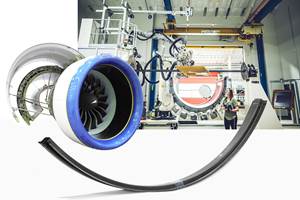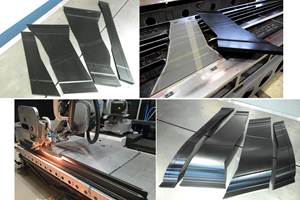Plasma treatment elevates aerocomposites surface preparation
CAMX 2024: Enhanced material performance and structural integrity, as well as reduced environmental impact is possible through Plasmatreat’s Openair-Plasma process.
Share
Plasma technology, like Plasmatreat’s (Hayward, Calif., U.S.) Openair-Plasma, aids in enhancing the adhesion and stability of bonded joints in large-format carbon fiber-reinforced polymer (CFRP) aerospace components, crucial for long-term performance and structural integrity.
According to the company, this is particularly true for large-area components molded from prepregs. Here, plasma is capable of eliminating solvent-based release agents used in molding prepregs like Frekote, simplifying demolding processes. This results in cleaner surfaces, reduced cycle times and improved structural uniformity, benefiting overall manufacturing efficiency.
Even traditional materials such as titanium and aluminum alloys used in rivets face challenges like corrosion in aircraft environments. Openair-Plasma treatment addresses these challenges through effective surface preparation, including micro-cleaning and activation. This ensures optimal application of anti-corrosion coatings, maintaining the reliability of critical assembly components.
Furthermore, PlasmaPlus nanocoatings represent a sustainable alternative to toxic hexavalent chromium (Cr6) primers through a plasma polymerization process — essentially a dry, chemical-free plasma coating method. By introducing a precursor, this technology not only offers effective corrosion protection but also enhances surface tension and coating adhesion without compromising environmental standards.
Plasmatreat notes that the integration of plasma technology signifies a significant shift towards sustainability and efficiency in aircraft manufacturing, promoting environmental responsibility and operational efficiency.
Related Content
-
The potential for thermoplastic composite nacelles
Collins Aerospace draws on global team, decades of experience to demonstrate large, curved AFP and welded structures for the next generation of aircraft.
-
Bladder-assisted compression molding derivative produces complex, autoclave-quality automotive parts
HP Composites’ AirPower technology enables high-rate CFRP roof production with 50% energy savings for the Maserati MC20.
-
Plant tour: Airbus, Illescas, Spain
Airbus’ Illescas facility, featuring highly automated composites processes for the A350 lower wing cover and one-piece Section 19 fuselage barrels, works toward production ramp-ups and next-generation aircraft.
Related Content
The potential for thermoplastic composite nacelles
Collins Aerospace draws on global team, decades of experience to demonstrate large, curved AFP and welded structures for the next generation of aircraft.
Read MoreBladder-assisted compression molding derivative produces complex, autoclave-quality automotive parts
HP Composites’ AirPower technology enables high-rate CFRP roof production with 50% energy savings for the Maserati MC20.
Read MorePlant tour: Airbus, Illescas, Spain
Airbus’ Illescas facility, featuring highly automated composites processes for the A350 lower wing cover and one-piece Section 19 fuselage barrels, works toward production ramp-ups and next-generation aircraft.
Read More3D-printed CFRP tools for serial production of composite landing flaps
GKN Aerospace Munich and CEAD develop printed tooling with short and continuous fiber that reduces cost and increases sustainability for composites production.
Read MoreRead Next
Welding is not bonding
Discussion of the issues in our understanding of thermoplastic composite welded structures and certification of the latest materials and welding technologies for future airframes.
Read MoreORNL nanofibers research strengthens bridge between fiber, matrix
A novel technique of depositing thermoplastic nanofibers enhances their strength, toughness and ability to withstand stress, removing the need for traditional methods like coatings.
Read MoreAll-recycled, needle-punched nonwoven CFRP slashes carbon footprint of Formula 2 seat
Dallara and Tenowo collaborate to produce a race-ready Formula 2 seat using recycled carbon fiber, reducing CO2 emissions by 97.5% compared to virgin materials.
Read More







